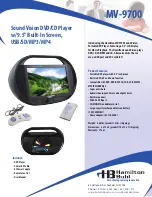
aXis CONTROLLER HOME STANDBY GENERATOR
INSTALLATION
35
The pins relate to a function of the aXis Controller module. These
functions control the operation of the HSB aXis Controller™
module. There are 15 pin locations. Remember the icons on the
front side of the module are only indicators of a run (GREEN) or
fault (Red). These are the designated pin locations, function and
wire colors for reference;
Pin Location
Function
Wire Color
Pin 1
B+
W(White)
Pin 2
B-
G (Green)
Used for two-wire start
Pin 3
Motor start signal
B/W (Black/White)
Pin 4
Fuel valve
G/B (Green/Black)
Pin 5
Alarm
L/B (Blue/Black)
Pin 6
Stop
L (Blue)
Pin 7
Signal to alternator
R/B (Red/Black)
Pin 8
Not Connected
Pin 9
Engine High Temp
Br (Brown)
Pin 10
Low Oil Pressure
Y (Yellow)
Pin 11
Used for two-wire start
Pin 12
Not Connected
Pin 13
Frequency Over/Under
R (Red)
Pin 14
Not Connected
Pin 15
Frequency Over/Under
B (Black)
DIP Switches (Bottom side of aXis Controller Module)
The 10 DIP switches relate to a program function of the aXis
Controller module. These functions control the operation of the
HSB. The figure below shows the designated factory switch
settings for reference.
CRANK
FQ2
I_AUX
I_LOP
I_HWT
FQ1
B-
ALARM
STOP
PREHEAT
FUEL
CHARGER
(D+)
B+
~
Rated Supply: 8~36 VDC (5A Max,)
(Terminal 13 and 15)
MAX WORKING VOLTAGE
300 VAC
!
DIP1_ENGINE STOP TIME
DIP2_ENGINE STOP TIME
DIP3_SYSTEM FREQUENCY
DIP4_OIL PRESSURE SWITCH TYPE
DIP5_AVR BOOST
DIP6_ENGINE COOLING TIME
vDIP7_ENGINE COOLING TIME
DIP8_IDLE OR PREHEAT
DIP9_PLC ACTIVE
DIP10_STARTER MOTOR STOP RPM
1
9
15
10
11
12
13
14
8
7
6
5
4
3
2
ON
9
1
10
8
7
6
5
4
3
2
Battery Charger
This automatic battery charger is an intelligent module which
maintains lead acid batteries at a full charge, when the HSB has
been properly installed. Continual monitoring and maintenance
will promote long battery life. In accordance with the principle of
high efficiency, at Full Load, >85% of efficiency is achieved. This
charger is a maintenance battery charger. If the battery voltage
falls below 6V, the charger will not re-change the batteries.
To properly maintain battery efficiency you must follow the
battery manufacturers; safety instructions, warnings and proper
maintenance procedures.
Feature benefits include; reverse polarity protection, short circuit
protection, overload protection, over voltage, over current, floating
charging system, constant voltage output and a rugged design
for industrial environments. This charger is for lead acid batteries
only. All adjustments are preset at the factory.
The automatic battery charger has five (5) built in LEDs that
display the following, view left to right;
NO CHARGE / PAS DE CHARGE /
SIN CARGA
AUTOMATIC BATTERY CHARGER /
CHARGE AUTOMATIQUE DE BATTERIE /
CARGADOR DE BATERÍA AUTOMÁTICO
Output: 24 Vdc 1.6 A
Producción: 24 V C.C. 1,6 A
Sortie : 24 V c.c. 1,6 A
Power: 80-125 Vac 1.0 A 50 / 60 Hz
Potencia: 80 - 125 V C.A. 1,0 A 50 / 60 Hz
Alimentation : 80-125 V c.a. 1,0 A 50 / 60 Hz
L
N
ADJ
E. O.
V
POWER / ALIMENTATION /
POTENCIA
OUTPUT / SORTIE /
PRODUCCIÓN
MODEL / MODÈLE / MODELO : 100482
POWER
ALIMENTATION
POTENCIA
Conforms to UL
Std. 1236
RECOGNIZED
COMPONENT
K
109
485
REFLEX BLUE
Colors
LPN
2484-L-PR
Rev
A
Size
76 x 75 mm
Artwork Notes
2mm safe margin; to be printed on White substrate.
Revision Changes
---
This artwork belongs to Champion Power Equipment. The contents are confidential and privileged and shall not be disclosed to or used by or for
outside parties without the explicit consent of Champion Power Equipment.
1. Power – Lit to indicate the battery is fully charged.
2. Small Bar – Lit to indicate the battery is receiving a trickle
charge.
3. Middle Bar – Lit to indicate current output is near 50%.
4. Large Bar – Lit to indicate the charger is operating above
50% capacity.
5. NO CHARGE – Lit to indicate a battery charging problem. If
this LED is lit, the LED icon on the aXis Controller module,
“LOW BATTERY” will also be lit.
The battery(s) might be discharged to a level that is too low to re-
charged with this charger (battery voltage below 6V). If this is the
case, the batteries will need to be charged individually. Remove
all battery cables from the batteries and follow the battery
manufacturers’ instructions on properly servicing/charging the
batteries.











































